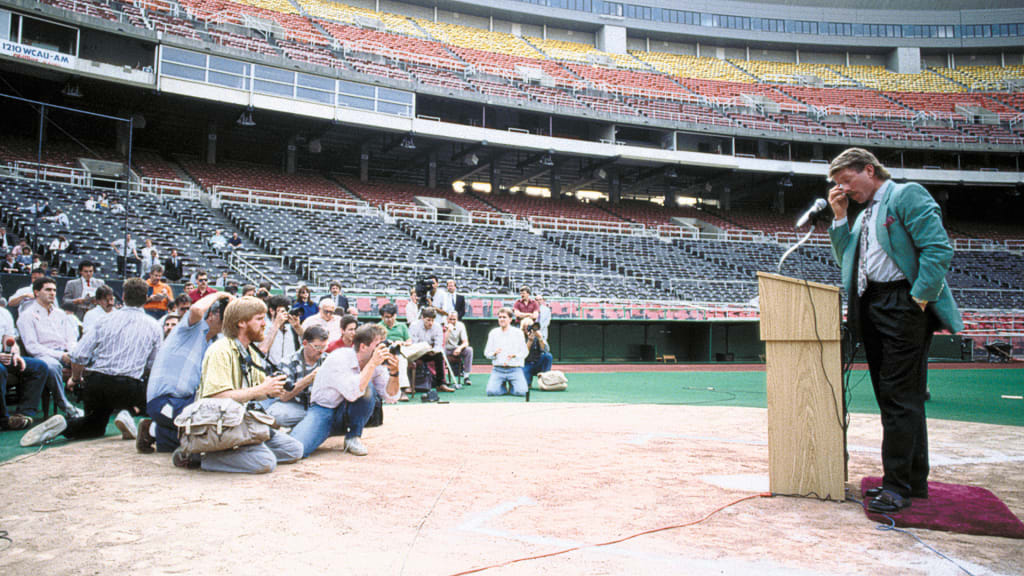
A lot of professional athletes don’t know when it is time to walk away. To Mike Schmidt’s credit, he knew. It happened on Memorial Day weekend in 1989.
Struggling with a .203 average on a last-place team, Schmidt committed an error on a routine ground ball that could have ended an inning. Will Clark followed with a grand slam that paved the way for the Phillies' fifth straight loss, 8-5, on a Sunday afternoon in San Francisco’s Candlestick Park.
Following that May 28 game, his 2,404th in a Phillies uniform, the 39-year-old made a very difficult decision, something that had been on his mind for weeks. It was time to call it a career. Other than his family and advisors, his decision shocked everyone.
Tremors from his earthquake-like decision vibrated all the way to Philadelphia. The aftershock was difficult to comprehend -- arguably the greatest third baseman in baseball history has retired.
Vince Nauss, the Phillies' publicity director who was on the trip, arranged for a press conference prior to the next game, which was the next night in San Diego. An empty auxiliary locker room adjacent to the Phillies clubhouse in Jack Murphy Stadium was the location for the gathering. It was a very emotional time for Mike.
“Some 18 years ago I left Dayton, Ohio, with two very bad knees," Schmidt said, sobbing. "With a dream to become a Major League player. I thank God this dream came true.”
Once he gained composure, he continued, “Over the years I’ve set high standards for myself as a player. I’ve always said that when I don’t feel I can perform up to those standards it would be time to retire. My skills to do the things on the field, to make the adjustments needed to hit, to make the routine plays on defense and to run the bases aggressively have deteriorated.
“I feel like I could easily ask the Phillies to make me a part-time player, to hang around for a couple of years to add to my statistical totals. However, my respect for the game, my teammates and the fans won’t allow me to do that. For that reason, I have decided to retire as an active player.”
Following that media conference, he flew home for another press conference the next day, this one with the Philadelphia media.
I decided we needed to do something special. A press conference in a windowless room on ground level at Veterans Stadium just didn’t seem appropriate. So we put the podium at home plate, where he made his mark. Instead of facing the pitcher, he faced the stands and the media that packed the warning track behind home plate. A box of tissues on the podium shelf came in handy.
Michael Jack Schmidt’s road from Dayton to Philadelphia wasn’t a smooth one.
First as a six-year old, he fell out of a tree. While slipping, he grabbed on to uninsulated wires carrying 4,000 volts. Fortunately, he was wearing sneakers. The juice went right through him into the ground. Aside from some burn scars, he survived and was back in school the next day.
Twice in high football (sophomore/junior years), he sustained separate knee injuries, the right one first. Off to Ohio University with two bad knees to study architecture and possibly play basketball. During his freshman year, an athletic trainer, doctor and insurance advisor told Mike he’d have to drop basketball because he was too much of a risk physically.
Told to strengthen each knee, Mike began physical therapy and two months later he was a switch-hitting shortstop on the baseball team.
Paul Owens, director of Minor Leagues and scouting, personally scouted him, “Good athlete, good size. He hit a home run and two or three other hits in a doubleheader; a better hitter from the right side. He was a shortstop but to me he was going to make an ideal third baseman.” The Phillies drafted him in the second round in the 1971 June draft.
He made his Major League debut in September 1972, wearing No. 22. His rookie year in 1973 was a struggle -- .196 average in 132 games and 18 home runs. He took off from there.
Mike led the National League in home runs a record eight times; OPS and extra-base hits five times; RBIs four times. He was awarded six Silver Slugger Awards for offensive excellence and 10 Gold Gloves for defensive excellence, most by an NL third baseman. A 12-time All-Star, elected a starter nine times. Three-time NL MVP and 1980 World Series MVP. At retirement, his 548 home runs ranked seventh all-time (third in the NL).
He held 14 MLB records, 18 NL records, 24 Phillies career records and 11 Phillies season records when he retired. On May 26, 1990, he was inducted into the Phillies Wall of Fame and his uniform No. 20 was retired.
Schmidt was elected to the National Baseball Hall of Fame in 1995, the 26th player to enter on his first ballot. Ironically, during his San Diego press conference, Phillies icon Richie Ashburn stood near Mike for support. In July 1995, they were both on the same Hall of Fame stage in Cooperstown, N.Y., a great moment in Phillies history.